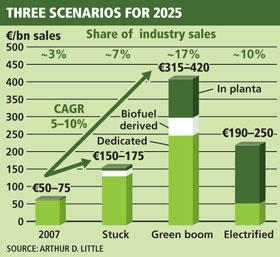 Bioplastics and - more generally - chemicals derived from biological raw materials such as wood and straw are being touted as the next big thing for the industry and its customers. Many regard the technology that will make this possible - industrial biotechnology (IB) - as a potential game-changer.
Bioplastics and - more generally - chemicals derived from biological raw materials such as wood and straw are being touted as the next big thing for the industry and its customers. Many regard the technology that will make this possible - industrial biotechnology (IB) - as a potential game-changer.The benefits for companies and consumers are the new and different functionalities of biological feedstocks. They can offer innovative and better products, and may, in addition, reduce environmental impacts. Indeed, IB advocates boast about lower net carbon emissions (since growing the feedstock would extract carbon dioxide from the atmosphere) while on the political-economic side, a bio-economy would rely less on oil imports from parts of the world deemed less stable.
But critics believe expectations are exaggerated. They argue that IB remains of little importance for chemical production overall, especially where IB products are more expensive than alternatives. Also, industry should not exploit valuable farmland that is needed to grow food and feed. In addition, they highlight that the petrochemical industry, using approximately 5% of all oil, contributes little to climate change.
Arthur D. Little has analyzed in detail both the current state and future path of IB. First, we have characterized what technologies can be used to make biochemicals and how big the market actually is. And second, we have evaluated what future developments may be expected and how companies can capitalize on these.
THE STATE OF PLAY
It is important to recognize that biochemicals can be derived through three fundamentally different technology platforms:
Dedicated production: The most developed branch of IB, involving the production of chemicals using enzymes through biocatalysis and whole cells through fermentation.
Biofuel-derived: Up-and-coming, but depends on the development path of biofuels, as it involves the production of chemically useful products as a by-product of biofuel (bioethanol and biodiesel) production.
In plants. Mostly uncertain but promising; production of chemicals by crops (possibly genetically modified) or algae, and extracting these after harvesting.
The table above right summarizes the key features of these segments, further split by high- and low-volume, with examples. Importantly, each of these platforms is shaped by different drivers and a failure to recognize the differences is already causing significant confusion in the debate, and may lead companies down the wrong strategic path without careful understanding of key differences here.
Using this view on the market, we estimate the current size of the biochemicals market to be 51bn-77bn ($61bn-93bn), or 3-4% of total global chemical sales - remarkably small given the publicity and optimistic growth projections of the past decade. Note that the analysis of the chemical IB market excludes biofuels - just like traditional gasoline and other fuels are not counted as chemical industry sales, biofuels should also not be included in the biochemicals market. Note also that pharmaceuticals constitute the most of today's sales - commodities are seldom IB-based.
A FUTURE OF GROWTH
To understand about "the size of the prize" and thus enable better decision-making by future producers and users, we have analyzed what different scenarios might apply for the IB market until 2025. We identify three:
Future 1 - Green boom: This is the most optimistic potential future for industrial biotechnology. It assumes that by 2025, many different technologies that we are talking about today have been commercialized. Thus, the world can grow and exploit agricultural feedstocks like straw and algae for biofuel production that do not compete with food crops. A thriving biochemical industry has developed, comparable to the petrochemical boom of the early 1900s - large-scale production of cheap fuel for a world demanding transport allows chemical companies to piggyback and valorize part of the fuel (and wastes) into useful chemicals.
Future 2 - Stuck: In this potential future for IB, even by 2025, the anticipated technology breakthroughs for large-scale biofuel production have remained elusive. Reasons include limited success in producing cheap, unsubsidized biofuels, societal resistance to genetically modified organisms and biofeedstocks being seen to compete with other land use. Only the direct production of fine and specialty chemicals grows successfully, but this technology was viable and profitable already before 2010.
Future 3 - Electrified: In this future, electric cars are breaking through on a large scale, driven by government policies and technological advances. As a result, a real or anticipated drop in demand for oil leads to structurally low prices for crude oil and thus naphtha, rendering existing petrochemical products highly competitive and preventing the growth of IB processes and products unless there is a clear cost or functional advantage.
 At present, no one scenario is more or less likely. Too much depends on difficult-to-predict technology breakthroughs: biofuel production; genetic modification; battery technology for electric cars; as well as in solar and wind energy to produce electricity for transport cheaply but without emissions. On this basis, our model shows that by 2025, the biochemical market will be worth 175bn-420bn, equal to a chemical production market share of 7-17% (see graph, left).
At present, no one scenario is more or less likely. Too much depends on difficult-to-predict technology breakthroughs: biofuel production; genetic modification; battery technology for electric cars; as well as in solar and wind energy to produce electricity for transport cheaply but without emissions. On this basis, our model shows that by 2025, the biochemical market will be worth 175bn-420bn, equal to a chemical production market share of 7-17% (see graph, left).
From these scenarios it is clear that IB will continue to grow and in fact outpace general chemical industry growth. That said, we do not expect the imminent transformation of the industry. A sector that has relied for nearly all of its feedstock on traditional petrochemistry will gradually shift towards one that has other options. IB would be another option in the toolkit, and the industry can choose to exploit alternative feedstocks.
Ultimately, the enthusiasm of the chemical-using industries (for example in food, cosmetics and electronics) to exploit some of the unique features of biochemicals will drive much of the nascent industry. Biochemicals can bring differentiated products and increased profitability in a three ways;
IB may allow existing products to be produced at a lower cost. Technologies such as biocatalysis and fermentation are sometimes used to make existing chemical products more simply, and using less energy;
IB technology will allow companies to achieve unique product features that are not achievable through traditional processes. For example, UK specialty chemical company Croda has developed a unique range of biochemical "active ingredients" that are more effective in "adjusting" dry or oily skin, wrinkle reduction, skin firming, protection from causes of skin damage among other benefits. Another example is 1,3-propanediol, pursued by a joint venture of US chemical giant DuPont and UK food group Tate & Lyle, and can be used as a building block for various derivatives and polymers;
Third, IB will create opportunities to market nature-based products, sold as renewable and offering reduced climate impacts. For example, Genencor, a division of Danish foods group Danisco, has teamed up with US tire maker Goodyear to produce bioisoprene, a key ingredient used to manufacture tires. The tires obtained would be partially renewable and have a lower climate impact.
Industrial biotechnology can be a big deal, but its scale to date remains small. Dramatic displacement of petrochemicals by IB-derived biochemicals is not anticipated, but there will be plenty of scope for companies that have an eye for the various unique features offered by the technology in its various forms.
Peter Nieuwenhuizen is a principal in Arthur D. Little's Amsterdam office. He is a member of SusChem Netherlands, and contributes to the WRI/WBCSD GHG Protocol Product and Supply Chain Initiative
FUTURE TECHNOLOGY PLATFORMS FOR INDUSTRIAL BIOTECHNOLOGY Technology platform Dedicated single compound production Biofuel-derived In planta Description Chemical production by means of enzymes or fermentation Production of chemicals as a by-product of biofuel production Production of chemicals in (genetically modified) crops or algae Feedstock Various, high-value glucose, sucrose Low-cost sugars, vegetable oils, biomass (e.g. straw, wood) Arable crops or algae Low volume (specialty and fine chemicals) Products include drugs, vitamins and amino acids from e.g. BASF and DSM. Numerous specialty companies and larger companies such as Avecia and Croda are active in this area Products include protein-based plastics or lignin-derived glues, sealants and detergents. Various start-ups are active here Products include PHA (polyhydroxyalkanoate) resins, from Metabolix/Archer Daniels Midland, and specialty oils from companies such as Croda High volume (Commodities and platform* chemicals) Products include acrylamide (from acrylonitrile by Mitsubishi Rayon), citric acid, succinic acid (DSM/Roquette), corn-derived 1,3-propanediol (DuPont Tate & Lyle BioProducts), Polylactic acid (NatureWorks), and Isoprene (Genencor) Products include ethanol, butanol (DuPont and BP), 1,3-propanediol (from glycerol, DuPont Tate & Lyle BioProducts ) Already, rubber is grown commercially in high volumes. Cereplast is offering starch-based plastics. Examples of future products could include (poly)methylmetacrylate, or acrylamid from cyanophycin NOTE: * Platform chemicals, defined as those to be transformed into other products SOURCE: ARTHUR D. LITTLE
Related News
- US cellulosic and algae biofuel producers are pushing for the Green Job Act of 2010 to be passed to apply tax credits to new biorefineries and boost employment
- The American Chemistry Council fights challenges from BP oil spill
- Car dealers say Beijing auto rules hurt
- Auto imports policy in the making





